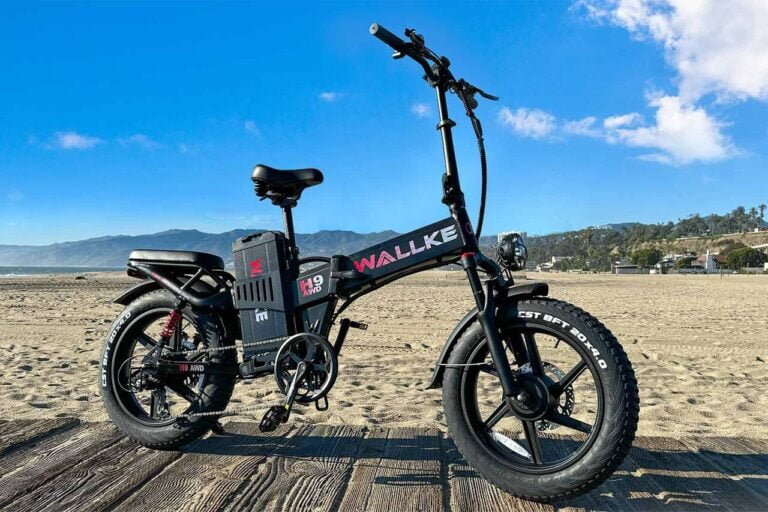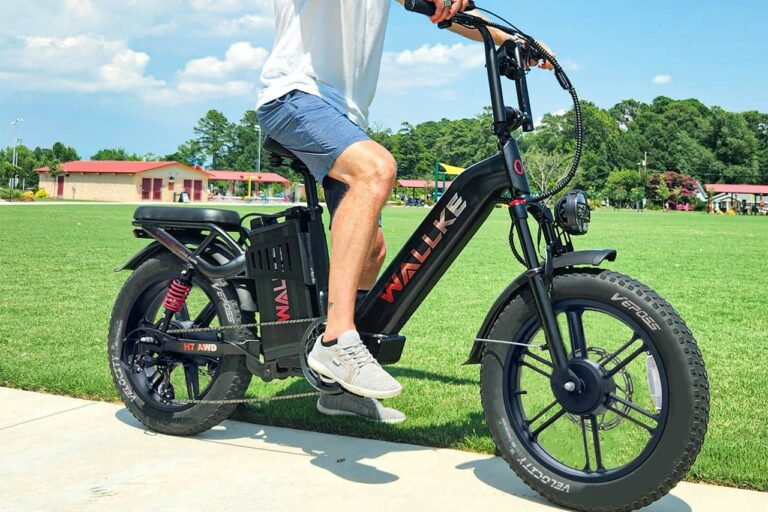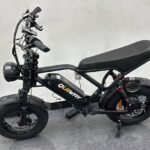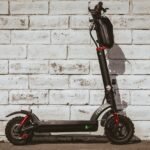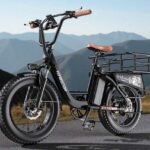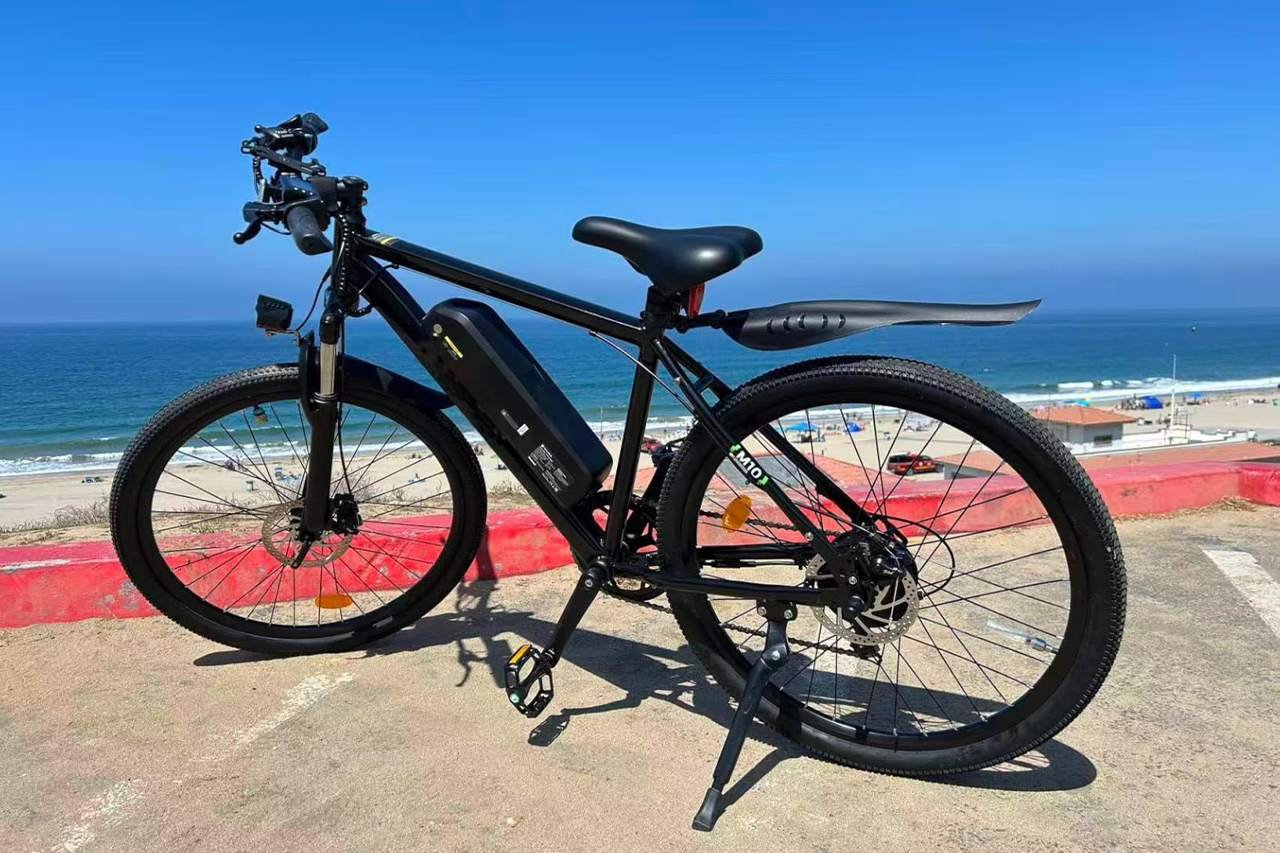
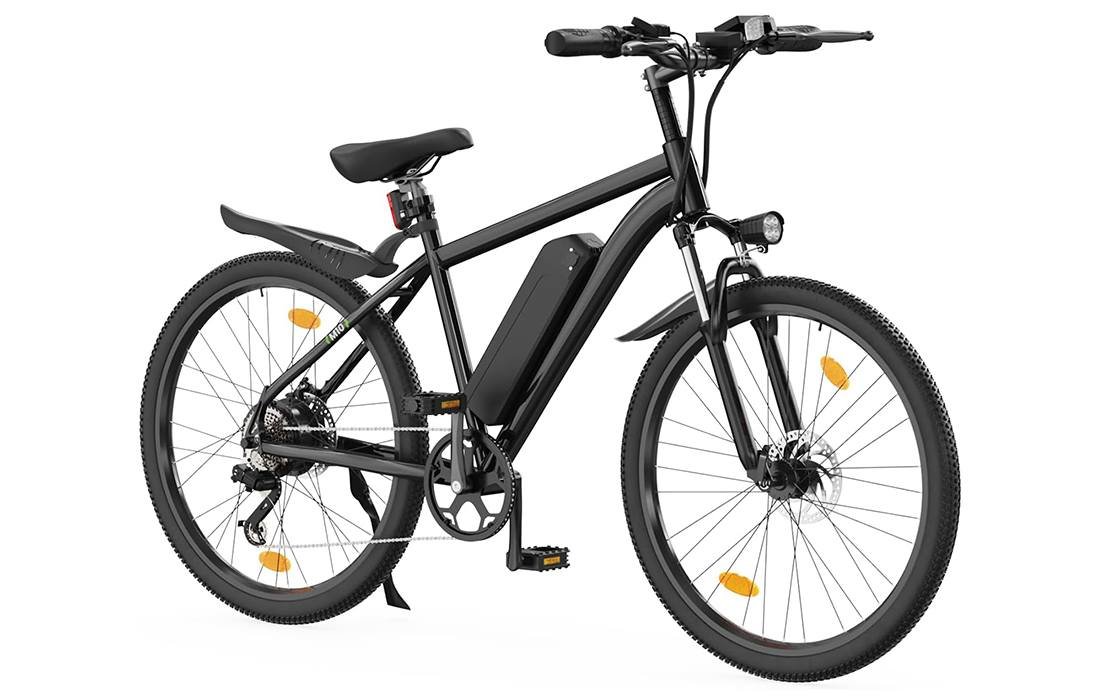
AYOLNY M10 Electric Bike — Budget Class-2 for Daily Rides
Our take: 750W-peak punch, removable 36V 10.4Ah battery with 3–4h fast charge, and a stable 26″ setup make this a smart starter for streets and park paths.
- 750W-peak hub with 5 PAS + throttle—brisk to 20MPH (Class-2)
- 36V 10.4Ah removable battery + UL-certified 42V/3A fast charge (3–4h)
- Alloy frame, front suspension, mech discs, LCD & lights; up to 330 lb
- Motor
- 750W peak rear hub
- Battery / Charge
- 36V 10.4Ah • 3–4h
- Top Speed
- 20 MPH (Class-2)
- Range
- Up to 55+ miles PAS
If you’ve been shopping for your first e-mountain/commuter hybrid and you keep landing on budget 26-inch bikes with modest power and simple controls, the AYOLNY M10 will look very familiar—except it sneaks in a few welcome surprises. It’s built around a lightweight aluminum frame with a front suspension fork, a removable 36V 10.4Ah battery, and a rear hub motor that peaks at 750W. Top speed is a Class-2-friendly 20 mph, and the brand claims up to “55+ miles” per charge in pedal-assist. On paper, that’s a compelling blend of price, practicality, and approachability.
What struck me right away is how well the package targets real-world riding: a UL-certified 42V/3A fast charger (3–4 hours for a full charge), an LCD display that’s legible at a glance, mechanical disc brakes, front and rear lights, and basic mudguards. The M10 ships 85% assembled, so the last bit is quick—bolt on the front wheel, handlebar, pedals, and you’re rolling. The drivetrain uses a 7-speed Shimano-pattern setup and five pedal-assist levels, making it easy for beginners to find a comfortable cadence on bike paths or neighborhood hills.
AYOLNY isn’t trying to win spec-sheet wars here. This is a starter e-bike for adults who want an honest daily ride: something that can commute during the week and handle light trails or park loops on weekends. The result is a bike that’s predictable, forgiving, and quietly confident for the money—so long as you understand its boundaries (36V power system, mechanical brakes, and a comfort-oriented fork).
Is AYOLNY M10 for you?
The M10 solves a familiar problem: how to get reliable electric assist, day-to-day utility, and trail-capable stability without spending a fortune or wrestling with an overpowered bike. If you’re new to e-bikes, Class-2 operation (20 mph with throttle and/or PAS) keeps things approachable. The 26-inch wheels roll quickly, the front suspension takes the edge off potholes and gravel, and the riding position is upright enough for visibility in traffic.
Great fit if you:
- Want a budget e-bike that still feels complete (lights, display, fast charger, basic fenders).
- Need a practical commuter that doubles as a park-trail cruiser.
- Prefer predictable Class-2 behavior rather than chasing 30+ mph speeds.
- Value easy ownership: removable battery, short charge times, simple 7-speed drivetrain.
Not ideal if you:
- Expect long, steep mountain climbs at high speeds or plan to carry heavy cargo daily.
- Want hydraulic brakes, a torque sensor, or a 48V/52V battery for stronger sustained power.
- Need full-suspension comfort or advanced off-road components.
Beginner friendliness is high. The PAS has five levels, the LCD keeps the basics front and center, and assembly is straightforward. Riders around 5’3” to 6’3” with an approx. 300 lb capacity will find the fit flexible and confidence inspiring. The overall package clearly aims at first-time buyers and value-seekers.
What We Like About the AYOLNY M10
For a budget e-MTB/commuter, the M10 checks a lot of boxes that matter in everyday use. The 750W-peak hub motor delivers snappy launches from stoplights and enough torque to crest neighborhood hills without drama. It’s not a rocket ship—nor is it trying to be—but it gets to 20 mph briskly and holds there smoothly. The 36V 10.4Ah battery is removable and secure, and pairing it with a 42V/3A charger is a thoughtful touch: fast top-ups are a big quality-of-life boost when you commute multiple days in a row.
The LCD dashboard feels pleasantly old-school in the best way—large, monochrome, readable. You get PAS level, speed, trip, and battery bars without diving into menus. The five PAS levels are spaced sensibly so you can fine-tune effort. Add the 7-speed drivetrain and you’ve got a simple, intuitive control scheme that riders learn in minutes. On bike paths and light gravel, the front suspension softens chattery surfaces, and the mechanical disc brakes offer consistent stopping in mixed weather.
I also appreciate the attention to commuter details. A front headlight that’s actually ride-worthy, a rear taillight for visibility, and basic mudguards mean fewer excuses to leave the bike at home. The bike ships 85% pre-assembled with tools—unbox, finish a few steps, check bolts, and ride. Finally, the aluminum frame and relatively modest total weight (around the mid-40-lb range for an e-bike) make it easier to lift onto a car rack or up a few steps than many competitors.
What We Don’t Like About the AYOLNY M10
First, know your power system. A 36V battery keeps costs and weight down, but it caps peak current delivery and sustained power vs. 48V/52V systems. The M10 rides best in the 20 mph Class-2 window; it’s not meant for extended high-speed runs or aggressive climbs with cargo. If that’s your use case, you’ll want more voltage and (ideally) a torque-sensor setup.
Second, mechanical disc brakes are fine at this price, but they require periodic cable adjustments and can feel less progressive than hydraulics—especially on long descents. The iron coil fork is rugged and low-maintenance, yet heavier and less tunable than mid-grade air forks; its job is comfort, not precision. The drivetrain and tires are likewise built to a budget—reliable for commuting and light trails, but not something I’d hammer down rocky singletrack.
Finally, while the bike includes lights and fenders, you don’t get racks, mounts for baskets are basic, and the LCD is functional rather than feature-rich (no color graphics, no app connectivity). None of this is a deal-breaker for a starter bike, but it’s worth knowing where the price savings come from.
Pros & Cons
| Pros | Cons |
|---|---|
| Predictable Class-2 performance to 20 mph; easy for new riders | 36V battery limits sustained power vs. 48V/52V systems |
| 750W-peak hub motor feels lively in city riding | Mechanical disc brakes require more adjustment; less bite than hydraulics |
| 42V/3A fast charger (3–4 hours) reduces downtime | Entry-level coil fork focuses on comfort; not ideal for rough trails |
| Removable 36V 10.4Ah battery; simple to charge on/off the bike | Basic LCD—clear but no app, nav, or advanced metrics |
| Clear LCD with 5 PAS levels; intuitive controls | Stock tires and saddle are commuter-level, not performance parts |
| 7-speed drivetrain: broad enough for flats and gentle climbs | Geared for city/light-trail pace, not high-speed or heavy cargo |
| Front & rear lights and mudguards included | |
| Ships 85% assembled with tools; beginner-friendly setup |
What’s Included?
- AYOLNY M10 aluminum e-bike (26″ wheels, front suspension)
- Removable 36V 10.4Ah lithium battery
- 42V 3A UL-certified charger (approx. 3–4 hour full charge)
- LCD display and bar-mounted PAS/throttle controls
- Mechanical disc brakes (front and rear)
- Front headlight and rear taillight
- Basic front and rear mudguards
- Kickstand and pedals
- Assembly toolkit and user manual
Package impressions: For a budget model, this is a complete commuter start kit. The inclusion of lights, fenders, and a fast charger saves you from immediate accessory spending, and the 85% pre-assembly shortens the path to your first ride. A rear rack would have made commuting plug-and-play, but given the price category, it’s a fair omission. Most riders will add a rack, bottle cage, and a better bell or mirror as they settle in.
Technical Specifications
| Category | AYOLNY M10 (Claimed/Observed) |
|---|---|
| Motor | Rear hub, 750W peak (geared) |
| Battery | 36V 10.4Ah (≈374 Wh), removable |
| Charger | 42V 3A; approx. 3–4 hours full charge |
| Top Speed | 20 mph (Class-2) |
| Pedal-Assist | 5 levels |
| Range (PAS) | 50–60 miles (conditions dependent) |
| Range (Throttle) | ~28–35 miles claimed in marketing materials |
| Drivetrain | 7-speed Shimano-pattern |
| Brakes | Mechanical disc (F/R) |
| Frame | Aluminum, hardtail |
| Fork | Iron coil front suspension (adjustable) |
| Wheel/Tire | 26″ MTB-style |
| Display | Monochrome LCD (speed/PAS/odo/trip/battery) |
| Lighting | Front headlight, rear taillight |
| Rider Fit | Approx. 5’3″–6’3″ |
| Load Rating | Around 300 lb (capacity varies by listing) |
| Ship State | 85% assembled with tools |
Features
- Class-2 20 mph assist for approachable city riding and path compliance
- 750W-peak geared hub for punchy starts and confident hill take-offs
- 36V 10.4Ah removable battery; charge on or off the bike
- Fast 42V/3A charger trims downtime to roughly 3–4 hours
- 5 PAS levels plus thumb throttle for flexible control
- 26″ wheels and front suspension for stable, cushioned handling
- Mechanical discs with all-weather reliability and easy cable service
- LCD dashboard with big, readable numerals (speed, PAS, odo, trip)
- Front headlight & rear taillight improve low-light visibility
- Basic mudguards reduce spray on wet roads
- 7-speed drivetrain balances simplicity with hill-friendly gearing
- 85% pre-assembled; toolkit and instructions included
Feature verdict: The M10 focuses on real-world essentials over flashy tech. You won’t find app connectivity or hydraulic stoppers, but you do get the pieces that make weekday riding painless: fast charging, clear display, reasonable range, and parts that local shops understand. The 36V system is the bike’s ceiling—great for Class-2 life, modest for extended steep climbs—but in return you get lower weight and cost.
Real-World Riding Notes
Power & Control. In PAS 1–2 the bike feels like a gentle tailwind—perfect for relaxed cruising. PAS 3–4 is the sweet spot for mixed terrain, where the 750W-peak bursts help you spin up to 15–18 mph with minimal effort. PAS 5 and throttle are best saved for short hops or headwinds; they’re fun but drain the battery fastest. Throttle response is smooth rather than jumpy, which helps new riders feel in control during stop-and-go traffic.
Climbing. Moderate hills are no problem when you combine PAS 3–4 with a sensible gear. On steeper grades, drop a gear or two and let the motor assist your cadence instead of trying to bulldoze the hill at top speed—this keeps the motor happy and preserves range. If your route is truly steep daily, plan on pedaling rather than relying on throttle alone.
Braking & Handling. The mechanical discs are easy to modulate and predictable in the wet; keep the cables snug and rotors clean and they’ll feel consistent. The 26-inch wheels make steering quick and familiar if you’ve ridden non-electric MTBs. On hardpack trails or broken pavement, the front suspension takes the sting out of chatter, though it’s not meant for drops or rock gardens.
Comfort. The stock saddle is typical of budget e-MTBs—fine for 30–45 minutes at a time. If you plan hour-plus rides, a saddle upgrade or suspension seatpost is money well spent. The bars are at a comfortable height, and the cockpit is roomy enough for riders on both ends of the fit spectrum. Tires favor efficiency over knobbiness; they’re happiest on pavement, packed dirt, and park paths.
Range Management. The advertised “up to 55+ miles” assumes conservative PAS on mostly flat ground with a lighter rider. In mixed city riding (some hills, stops, and occasional throttle), expect something more like 25–45 miles depending on assist level and weight. The big win is the 3–4 hour recharge time—top off at the office and you’ll always ride home with comfortable buffer.
Maintenance. Everything here is common and serviceable: mechanical brakes, a 7-speed derailleur, bolt-on accessories. Keep an eye on brake pad wear, cable stretch, and spoke tension during the first few weeks—the usual shakedown on any new bike—and you’re good.
Who Should Upgrade Later?
If the riding bug bites hard and you want more speed, stronger sustained climbing, and lower-effort braking, the typical next steps are a 48V/52V platform with hydraulic discs and a torque sensor. Those upgrades deliver a more natural pedaling feel and reduce hand fatigue on long descents.
For many riders, though, the M10’s balance of features and price hits the current sweet spot; the best upgrade might simply be tires, a rear rack, and a better saddle.
Accessory Recommendations
- Rear rack + trunk bag for commuting and groceries
- Mirror and bell for urban visibility and communication
- High-volume floor pump with gauge to keep rolling resistance low
- Suspension seatpost (optional) if you ride lots of choppy streets
- Spare brake pads & cable lube—cheap and handy
These small additions turn the M10 into a competent everyday hauler without overspending.
Final Breakdown
8.6 / 10
The AYOLNY M10 nails the brief: an approachable, budget-friendly e-bike that feels complete out of the box and rides with an easy confidence. It’s quick to 20 mph, comfortable on imperfect streets and park paths, and simple to live with thanks to its removable battery and fast 3–4 hour charging. The mechanical brakes and coil fork are honest choices at this price, and the 36V system—while not built for high-speed hammering—keeps weight and cost in check.
I recommend the M10 to first-time buyers, value-minded commuters, and anyone who wants a light-trail-capable city bike that won’t overwhelm them with power or complexity. Understand its limits, add a rack and a few comfort touches, and you’ve got a reliable daily ride that’s far better than “entry level” suggests.


